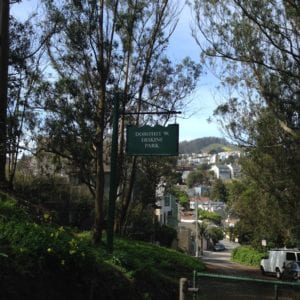
(Note: The title of this post was generated by ChatGPT, AI chatbot, courtesy of Octavio Di Sciullo. The rest was generated by a human.)
The Trust for Public Land says San Francisco is the first U.S. city where all residents live within a 10-minute walk to a public park. Most people would be thrilled to live a stone’s throw from one of our city parks. Trees and other natural features and wildlife provide calm and respite for nearby residents.
But not always.
Dorothy Erskine Park exists in a corner of the Glen Park neighborhood. It encompasses a mere 1.5 acres at Martha Avenue and Baden Street–it’s easy to miss among the total 5,384 acres of city parks. Beyond some sweeping vista views to the southeast, it has few if any features that would draw people to it, other than dogwalkers and birdwatchers. There are no benches for the weary. Furthermore, it is dwarfed by the wildly popular and nearby 70-acre Glen Canyon Park, with its multitude of recreational facilities, wild spaces and hiking trails that attract people from all over the Bay Area.
Dedicated in 1979, the park was named after Dorothy Erskine (1896 – 1982), founder of both SPUR (the San Francisco Bay Area Planning and Urban Research Association) and the Greenbelt Alliance. Erskine is featured in the Glen Park Women Hall of Fame, an exhibit by Evelyn Rose of the Glen Park Neighborhoods History Project on display at the Glen Park Branch Library through March 31.
For a complete history of the park, read the story in the Sunnyside history website.
“This small Natural Area offers outstanding City views, recreational opportunities, a diverse native grassland and scrub habitats, and urban forest areas,” notes the San Francisco Parks Alliance website.
Dorothy Erskine Park hovers high above homes on the 1100 block of Bosworth Street and goes unnoticed for the most part, until the heavy rains that began in December awakened menacing forces of nature.
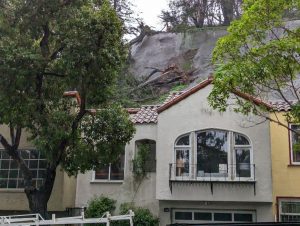
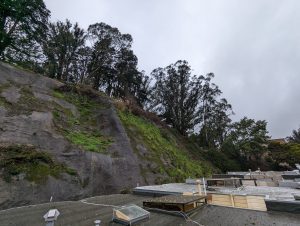
The atmospheric rivers (also called the Pineapple Express) that have bombarded California for several months now hit Glen Park on December 11, 2022, after which a large pine tree tumbled over and fell off the steep retaining wall that separates Dorothy Erskine Park from the houses below, crashing into the rear of several of them that front onto Bosworth Street.
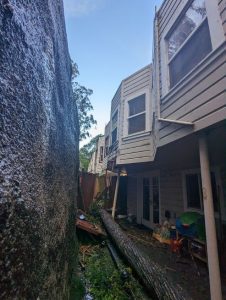
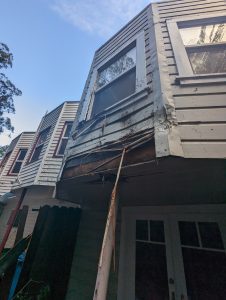
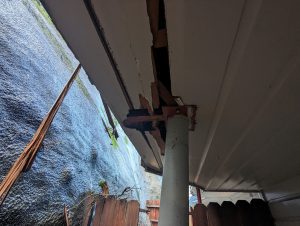
Subsequently, two or three more trees in the same spot fell over and came to rest, dangling precariously at the midpoint of the retaining wall.
A resident at one of the houses, Octavio Di Sciullo, reported to the Glen Park News that, “The tree caused an inside wall breach in my daughter’s bedroom, a couple of feet away from where she was sleeping, showering her bed with plaster and paint dust that was later found to contain traces of lead.” His family has been, and still is, displaced from their home while working with insurance to get their home repaired.
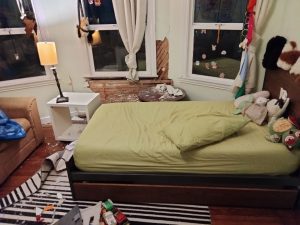
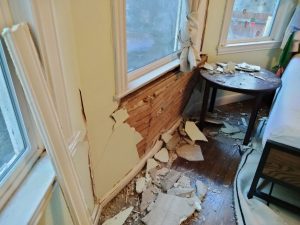
Damage to several homes is extensive. There is severe exterior structural damage and one deck was destroyed as well as three fences. Inside, personal effects are contaminated by lead paint, dust and debris. A bedroom wall was breached in two homes, leaving them uninhabitable. A deck at a home on Burnside Avenue was also partially destroyed.
The neighbors requested urgent help from SF311 and the San Francisco Parks and Recreation Department (SFRPD), which responded quickly and removed the fallen tree.
Of great concern to the neighbors was the forecast of a continuing series of storms, bringing much more rain and wind that could detach the still-dangling trees from their threatening positions, causing a crash into their homes yet again.
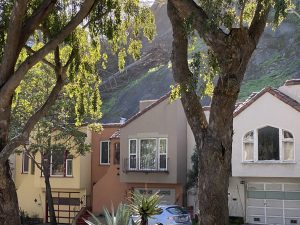
In February of this year, after the January 4 storm, the dangling trees were removed, causing some exterior damage to homes.
Now neighbors are worried about other trees that remain on the edge of the retaining wall in Dorothy Erskine Park. Would they withstand repeated storms?
Age and disease are the main factors that cause trees to blow over. Compromises to their structural integrity makes them more vulnerable. In addition, newly-planted trees are more likely to topple during high winds.
No tree is 100 percent safe from excessive wind and rain—even the strongest ones with good root systems can be at risk.
Here’s some information about how to know if trees nearby are at risk of falling.
Requests for proactive evaluation and removal of the trees at the edge of the retaining wall were met with negativity. Neighbors were told it was unlikely because of the “authorizations required.” However, SFRPD did send an arborist for an initial assessment, who determined that the trees in Dorothy Erskine Park are in dire need of maintenance to reduce the risk of additional collapse. They recommended height reduction and limb trimming and a thorough inspection.
Octavio Di Sciullo, one of the homeowners, has been having many exchanges throughout the ordeal with the Natural Resources Manager of SFRPD, who was trying to help navigate the city bureaucracy toward a safe resolution. Likewise, Supervisor Mandelman’s office became involved.
At the suggestion of the City Attorney’s office, one neighbor filed a claim for reimbursement for damages from the City Attorney, only to be denied by the same City Attorney.
In an illogical word salad, the office responded “Your claim was denied because our investigation into the incident found that the tree was located on unimproved land, and that there is no record that the City was notified it was in danger of falling.”
Supervisor Mandelman’s office found that there’s no formal appeals process to challenge the decision of the claims division. The only path forward would be to bring a lawsuit against the city.
The neighbors wonder: Does the city not hold itself responsible for trees located on public land?
They also wonder: Is it the public’s responsibility to assess whether a tree in a public park is in danger of falling?
Earlier this month SFRPD committed to having the trees on the edge of the retaining wall fully assessed by the Urban Forestry Tree Crew. No actual date has been given due to the necessity of first getting all the parks reopened, fallen trees removed, and cleaning up tree damage from the several storms.
In the meantime residents on the 1100 block of Bosworth wait for the inspection—and worry.
Repairs are still underway in three homes and are unlikely to be completed before the end of June. One family will remain displaced for that time.
They wonder if the inspection results will be shared with concerned neighbors.
They wonder if maintenance will be done in time for next winter.
Di Sciullo and his neighbors are living with a lot of uncertainty. “I’m increasingly resigned to the fact that we’re going to have to keep chasing the city to do the right thing for several months,” he says. “But hey, maybe I will be proven wrong!”